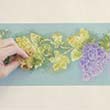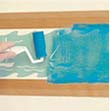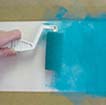 |
Stencils by the Yard are extra long stencils making
your stenciling job fast and easy. Stencils by the Yard are one overlay
stencils cut from mylar that measures 6" x 36". It's so easy. Just choose
the method that fits your schedule and the look that appeals to you, then
apply the paint in one of three ways. For a quick application, try the
super speedy method—roll the design on with one color. Want some
texture? Use the speedy method—sponge the design using multiple colors.
For a more detailed look, use the standard method—apply multiple
colors with stencil brushes.
supplies needed
Supplies you will need for all methods: paper towels, repositionable spray
adhesive, masking tape, ruler, level and a pencil. To roll, you will also
need: paint tray, 3" low knap or foam roller and acrylic paint. To sponge,
you will also need: sea sponge, acrylic paint and a plastic tray or plate.
To brush, you will also need: Spill Proof Stencil Paint and stencil brushes. |
| optional background and decorative stencils |

Place "Easy Mask" tape (brown painters tape)
in two level lines 6" apart. Roll or sponge a color in the 6" space
to create a colored background for your stenciled design. Center the stencil
vertically between the lines of tape and paint right off the edge of the
stencil overlapping the tape. This will give you a straight edge when
you are finished. Some of the Stencils by the Yard have a decorative edge
as part of the design. If you would like, you can leave off the tape and
paint off the edge of the stencil for a less structured look.
how to use triangle registration system how to stencil
|
how to roll |

Roll a 3" (approximately) low knap or foam roller
in acrylic or latex paint. Run roller over several layers of paper towel
to remove excess paint. The roller should be almost dry. Roll paint over
cutout areas of the stencil. Make sure to cover the triangle registration
marks and text on the stencil with masking tape so the paint doesn't go
through those areas. Clean stencil frequently with a damp sponge (water
base paints) to avoid paint build up.
|
how to sponge |
 Wet
a small piece of a natural sea sponge with water and wring out the excess.
(Sponge should be damp not soaked.) Dab sponge in paint. Blot excess paint
off of the sponge onto paper towels. The sponge should be almost dry.
Sponge paint over cutout areas of the stencil. Make sure to cover the
triangle registration marks and text on the stencil with masking tape
so the paint doesn't go through those areas. Clean stencil frequently
with a damp sponge (water base paints) to avoid paint build up. Wet
a small piece of a natural sea sponge with water and wring out the excess.
(Sponge should be damp not soaked.) Dab sponge in paint. Blot excess paint
off of the sponge onto paper towels. The sponge should be almost dry.
Sponge paint over cutout areas of the stencil. Make sure to cover the
triangle registration marks and text on the stencil with masking tape
so the paint doesn't go through those areas. Clean stencil frequently
with a damp sponge (water base paints) to avoid paint build up. |
how to stencil with brushes |

Remove the protective skim coat which forms on the top of Spill Proof
stencil paint. Swirl your stencil brush in the paint. Blot excess paint
off of the brush onto paper towels. The brush should be almost dry.
Stencil paint over cutout areas of the stencil. Apply paint with a circular
motion of the brush. Clean stencil frequently to avoid paint build up.
With water base paints, use a damp sponge. With Spill Proof paint, use
a dry paper towel or follow paint manufacturer's instructions. |
|
clean up
Clean stencil with paper towel which has been
dampened with turpentine or mineral spirits if using oil based paint.
Use water for water based paint.
|